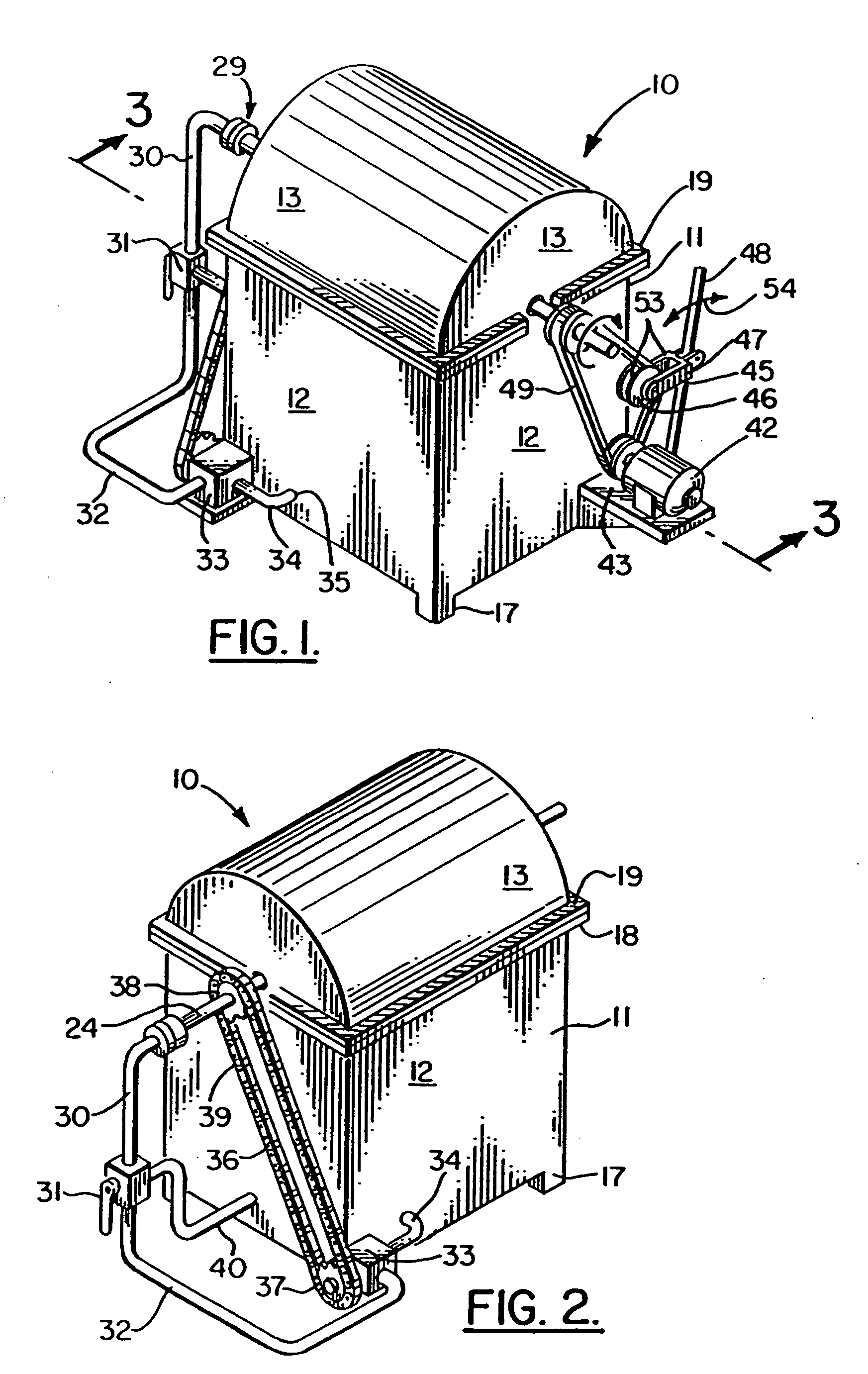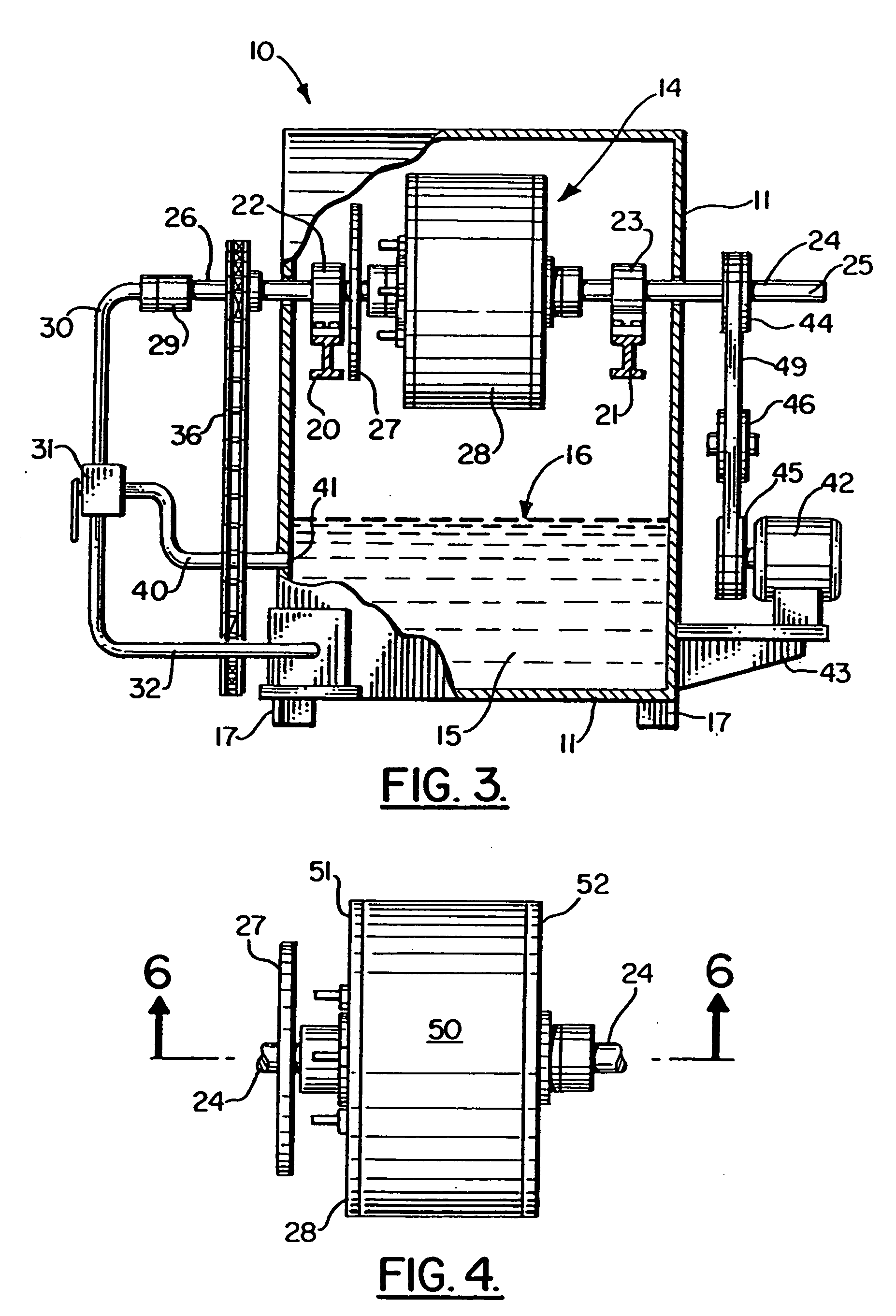Micro-combustion chamber heat engine
a heat engine and combustion chamber technology, applied in the field of micro-combustion chamber heat engines, can solve the problems of heat loss, unharnessed (wasted) work, frictional loss and unharnessed work, and all eight cylinders are constantly contributing to frictional loss,
- Summary
- Abstract
- Description
- Claims
- Application Information
AI Technical Summary
Benefits of technology
Problems solved by technology
Method used
Image
Examples
second embodiment
[0099]FIGS. 13-25 show the apparatus of the present invention designated generally by the numeral 110 in FIGS. 13, 14, and 15. Combustion engine 110 has an enlarged housing 111 with an interior 114. The housing 111 is comprised of upper and lower sections including a lower reservoir section 112 and an upper cover section 113.
[0100] Fluid 115 is contained in the lower portion of reservoir section 112 as shown in FIG. 15, the fluid 115 having a fluid level 116 that is well below chamber 128 and drive shaft 124. The fluid can be any combustible fluid including automatic transmission fluid, hydraulic fluid, vegetable oil, corn oil, or peanut oil, for example. A plurality of feet 117 can be used to anchor housing 111 to a pedestal, mount, concrete base, or like structural support. A pair of sealing mating flanges 118, 119 can be provided respectively on housing sections 112, 113 to form a closure and seal that prevents leakage during use.
[0101] A pair of spaced apart transversely extend...
third embodiment
[0124]FIGS. 26-34 show the apparatus of the present invention designated generally by the numeral 210. Combustion engine 210 includes a housing 211 having a reservoir section 212 and a cover 213 that is removably attached to the reservoir section 212. The interior 214 of housing 211 is partially filled with fluid 215, the fluid level being indicated by arrow 216. Housing 211 can be provided with a plurality of feet 217.
[0125] In order to perfect a fluid seal between reservoir section 212 and cover 213, a pair of peripheral mating flanges 218, 219 are provided. The flange 218 is on the reservoir section 212. The flange 219 is on the cover section 213.
[0126] In FIG. 28, a pair of beams 220, 221 support bearings 222, 233 respectively. Bearings 222, 223 support drive shaft 224. Drive shaft 224 has a starter end portion 225 and a fluid inlet end portion 226. In this application, directions of rotations of various parts will be referred to as either clockwise rotation or counterclockwise...
fifth embodiment
[0147]FIGS. 37-47 show generally the apparatus of the present invention, designated generally by the numeral 315 in FIGS. 37, 38, and 39. Combustion engine 315 has an enlarged housing 316 with an interior 319. The housing 316 is comprised of upper and lower sections including a lower reservoir section 317 and an upper cover section 318.
[0148] Fluid 320 is contained in the lower portion of reservoir section 317 as shown in FIG. 39, the fluid 320 having a fluid level 321 that is well below chamber 333 and drive shaft 329. The fluid 320 can be most any combustible fluid including automatic transmission fluid, hydraulic fluid, vegetable oil, corn oil, peanut oil, for example.
[0149] A plurality of feet 322 can be used to anchor housing 316 to a pedestal, mount, concrete base, or like structural support. A pair of sealing mating flanges 323, 324 can be provided respectively on housing sections 317, 318 to form a closure and seal that prevents leakage during use.
[0150] A pair of spaced a...
PUM
 Login to View More
Login to View More Abstract
Description
Claims
Application Information
 Login to View More
Login to View More - R&D
- Intellectual Property
- Life Sciences
- Materials
- Tech Scout
- Unparalleled Data Quality
- Higher Quality Content
- 60% Fewer Hallucinations
Browse by: Latest US Patents, China's latest patents, Technical Efficacy Thesaurus, Application Domain, Technology Topic, Popular Technical Reports.
© 2025 PatSnap. All rights reserved.Legal|Privacy policy|Modern Slavery Act Transparency Statement|Sitemap|About US| Contact US: help@patsnap.com



